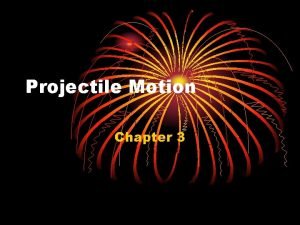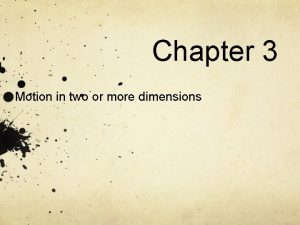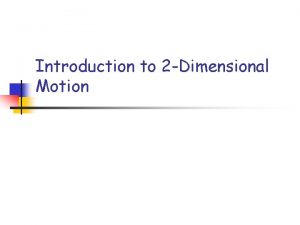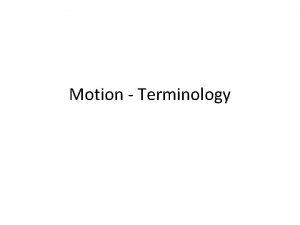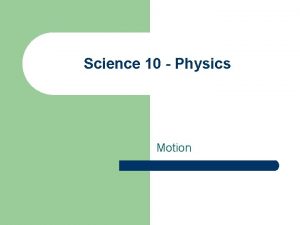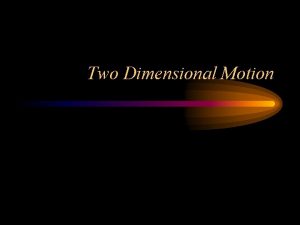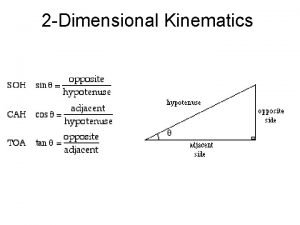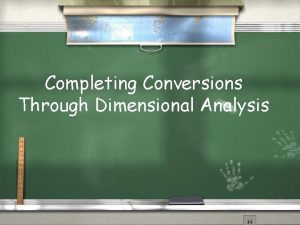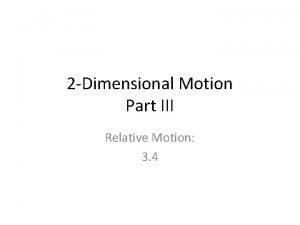1 Dimensional Motion Key Concepts Relative Motion Scalar











- Slides: 11

1 -Dimensional Motion �Key Concepts • Relative Motion • Scalar and Vector • Distance vs. Displacement • Velocity • Acceleration

Relative Motion � All motion is relative to other objects. � Observations of motion are based on the frame of reference. � An object is moving relative to the frame of reference. � The most common frame of reference is the earth.

Terminology �Scalars are quantities which are fully described by a magnitude alone. �Magnitude is the quantity that describes a unit of measure. Magnitude tells us how big something is. �Vectors are quantities which have a magnitude and direction.

Displacement � Displacement is not same as the total distance traveled. � Displacement point of origin. is relative to an axis and/or � Displacement is a measure of where an object is relative to its starting position. � Displacement is a directional quantity.

Displacement o "x" displacement means you are moving horizontally either right or left. o "y" displacement means you are moving vertically either up or down. o The word change is expressed using the Greek letter ∆ (delta). o To find the change you ALWAYS subtract initial position from the final postion. (∆x = xf – x 0) o It is therefore expressed as either positive or negative.

Distance � Distance is defined to be the magnitude or size of displacement between two positions. � The distance between two positions is not the same as the distance traveled between them. � Distance traveled is the total length of the path traveled between two positions. Distance has no direction and, thus, no sign.

Example: Displacement � Katie walks in a straight line from her locker (at a position x = 2. 0 m) toward the cafeteria at a position x = 12. 0 m). Along the way, Jack joins Katie on her walk to lunch from her locker (at a position x = 5. 0 m). As they arrive at the cafeteria, Katie realizes she did not bring her lunch so both students walk back to Katie’s locker. 1. What was Katie’s displacement when he walked from her locker to the 2. 3. 4. 5. cafeteria? What was Jack’s displacement when she walked from her locker to the cafeteria? What was Jack’s distance traveled for his entire trip? What was Katie’s displacement for her entire trip? What was Jack’s displacement for his entire trip? 1. +10. 0 m 4. 0. 0 m 2. +7. 0 m 5. -3. 0 m 3. 17. 0 m

Velocity � Average velocity is displacement (change in position) divided by the time of travel. � Average velocity = v= x t = xf – x 0 tf – t 0 � Instantaneous velocity is the average velocity at a specific instant in time. � Instantaneous velocity can be calculated two ways 1) with calculus 2) finding the slope of a tangent line on a displacement-time graph.

Speed �In everyday life, speed and velocity are often used interchangeably. They are not the same in physics! �Instantaneous speed is the magnitude (size) of the velocity. �Average speed = distance traveled divided by elapsed time.

Calculating Velocity �An athlete runs from the 20. 0 m line to the 100. 0 m line in 12. 20 seconds. What is her velocity?

Acceleration �Average acceleration is the change is velocity over time. a= v t = vf – v 0 tf – t 0
 Circular motion is one dimensional or two dimensional
Circular motion is one dimensional or two dimensional Is projectile motion a scalar or vector
Is projectile motion a scalar or vector Chapter 2 motion section 1 describing motion answer key
Chapter 2 motion section 1 describing motion answer key Describing and measuring motion
Describing and measuring motion Section 1 describing motion worksheet answer key
Section 1 describing motion worksheet answer key Describing motion chapter 1 lesson 1
Describing motion chapter 1 lesson 1 Kinematics 2d formulas
Kinematics 2d formulas Two dimensional motion
Two dimensional motion Two dimensional motion definition
Two dimensional motion definition Stage 15 relative clauses and relative pronouns
Stage 15 relative clauses and relative pronouns What is joint relative frequency
What is joint relative frequency Relative pronouns and relative clauses
Relative pronouns and relative clauses

